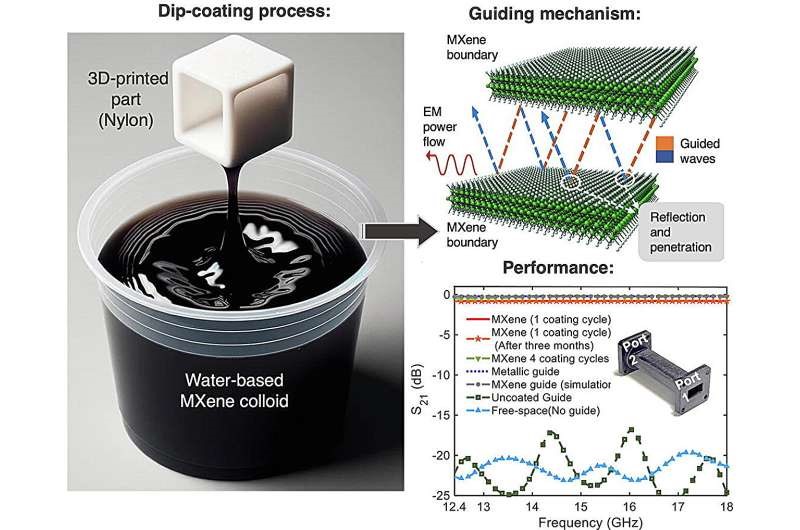Description

Disclaimer: Copyright infringement not intended.
Context
Astronomers, utilizing data from NASA’s Transiting Exoplanet Survey Satellite (TESS), have made a groundbreaking discovery: a super-Earth exoplanet located within the habitable zone of the nearby red dwarf star TOI-715.
Details
Background
- Waveguides are essential components in satellites for guiding radio waves, but their metal construction adds significant weight to payloads.
- Researchers aimed to create lightweight waveguides using 3D-printed polymers coated with MXene, a conductive nanomaterial.
MXene Coating
- MXene materials provide a thin coating that imparts electrical conductivity to non-conductive polymer components, such as 3D-printed polymers.
- MXene flakes are a few atoms thick, making them one of the thinnest possible coatings for achieving conductivity.
- MXene coatings can be applied simply by dipping the components in MXene dispersed in water, providing a cost-effective and straightforward manufacturing process.
Research Findings
- Waveguides act as pipelines for microwaves, directing signals to receivers while preserving signal quality.
- MXene-coated nylon waveguides weigh significantly less than standard aluminum waveguides, contributing to overall payload reduction.
- The MXene coating bonded well to 3D-printed nylon waveguides and demonstrated efficient transmission of electromagnetic waves.
- MXene-coated waveguides exhibited transmission efficiencies of up to 81%, with potential for optimization through varying coating layers and MXene flake sizes.
- Performance remained stable across different frequency bands and input power levels, indicating durability and suitability for space applications.
- MXene-coated waveguides offer a lightweight and low-cost alternative to metal waveguides, with potential applications in terrestrial as well as space-based systems.

What is MXene?
- MXene is a family of 2D transition metal carbides, nitrides, and carbonitrides discovered in 2011 by researchers at Drexel University.
- The name "MXene" (pronounced "max-een") comes from its structure: "M" represents the transition metal, "X" represents carbon or nitrogen, and "ene" refers to the presence of functional groups such as hydroxyl (-OH) and/or fluorine (-F) on the surface.
- MXenes are typically synthesized from layered ternary carbides, nitrides, or carbonitrides, known as MAX phases.
- These MAX phases have a general formula of M_n+1AX_n, where "M" is an early transition metal, "A" is an A-group element (usually group 13 or 14), "X" is carbon.
Properties:
- Excellent electrical conductivity.
- High surface area.
- Good mechanical strength.
- Chemically stable in various environments.
- Tunable surface chemistry.
Synthesis Methods:
- Selective Etching: MXenes are typically produced by selective etching of the A layers from MAX phases using a combination of strong acids or fluorides.
- Various Techniques: Synthesis methods include hydrofluoric acid etching, fluoride intercalation, and exfoliation.
Applications of MXenes:
- Energy Storage: MXenes show promise in supercapacitors, batteries, and fuel cells due to their high conductivity, large surface area, and ability to accommodate ions.
- Catalysis: MXenes have been explored as catalysts for various reactions including hydrogen evolution reaction (HER), oxygen reduction reaction (ORR), and water splitting.
- Electronics: MXenes are investigated for applications in flexible electronics, transparent conductive films, and electromagnetic interference shielding due to their conductivity and mechanical flexibility.
- Sensors: MXenes have shown potential in gas sensors, biosensors, and environmental monitoring devices due to their high surface area and sensitivity to chemical and biological species.
- Biomedical Applications: MXenes are being explored for drug delivery, imaging, and tissue engineering due to their biocompatibility and ability to load therapeutic agents.
Challenges and Future Directions:
- Scalable Synthesis: Developing scalable and cost-effective synthesis methods for large-scale production of MXenes.
- Understanding Properties: Further understanding the relationship between MXene structure, composition, and properties to tailor them for specific applications.
- Integration: Integrating MXenes into functional devices and systems while maintaining their unique properties.
- Environmental Impact: Addressing potential environmental and health concerns associated with MXene synthesis and applications.
Recent Advances:
- Functionalization: Surface functionalization of MXenes to enhance their stability and compatibility with different environments.
- Composites: Incorporation of MXenes into composites with polymers, ceramics, or other 2D materials to achieve synergistic properties.
- New Applications: Exploration of MXenes in emerging areas such as quantum computing, photonics, and flexible electronics.
About Transition Metals
- Transition metals are a group of chemical elements found in the middle of the periodic table, specifically in groups 3 through 12.
- They have unique properties that distinguish them from other elements, making them crucial in various industrial, technological, and biological processes.
Properties of Transition Metals:
- Variable Oxidation States: Transition metals can exhibit multiple oxidation states due to the availability of d orbitals in their electron configuration, allowing them to form various compounds.
- Complex Formation: They readily form complexes with ligands due to their partially filled d orbitals, leading to the formation of coordination compounds.
- High Melting and Boiling Points: Transition metals generally have high melting and boiling points compared to other elements, indicating strong metallic bonding.
- Catalytic Activity: Many transition metals and their compounds serve as catalysts in chemical reactions due to their ability to undergo redox reactions and form intermediates.
- Magnetic Properties: Some transition metals and their compounds exhibit paramagnetic, diamagnetic, or ferromagnetic properties due to the presence of unpaired electrons.
Common Transition Metals:
- Iron (Fe): Widely used in the production of steel and alloys, as well as in magnets and catalysts.
- Copper (Cu): Known for its excellent conductivity, copper is used in electrical wiring, electronics, plumbing, and as a component in alloys.
- Titanium (Ti): Renowned for its strength-to-weight ratio and corrosion resistance, titanium finds applications in aerospace, medical implants, and chemical processing.
- Nickel (Ni): Used in the production of stainless steel, batteries, and as a catalyst in chemical reactions.
- Cobalt (Co): Essential in the production of rechargeable batteries, magnets, and catalysts, particularly in the petroleum industry.
- Platinum (Pt): Valued for its catalytic properties, platinum is used in catalytic converters, fuel cells, and jewelry.
- Vanadium (V): Utilized in steel production, as well as in batteries, catalysts, and ceramics.
- Manganese (Mn): Important in steelmaking, as well as in batteries, ceramics, and fertilizers.
Applications of Transition Metals:
- Metallurgy: Transition metals are crucial in the production of alloys such as stainless steel, bronze, and brass, which possess superior mechanical and chemical properties.
- Electronics: Transition metals and their compounds are used in various electronic devices, including semiconductors, magnets, and superconductors.
- Catalysis: Transition metals serve as catalysts in numerous industrial processes, including petroleum refining, chemical synthesis, and environmental remediation.
- Biological Functions: Several transition metals, such as iron, copper, and zinc, play essential roles as cofactors in enzymatic reactions and biological processes within living organisms.
- Energy Storage: Transition metal compounds are utilized in batteries and fuel cells for energy storage and conversion applications.
- Medicine: Transition metal complexes are investigated for their potential as anticancer agents, diagnostic imaging agents, and therapeutic drugs in medicine.
.jpg)
Conclusion
MXenes represent a versatile class of 2D materials with a wide range of applications spanning from energy storage to biomedical devices. Ongoing research efforts aimed at improving synthesis techniques, understanding fundamental properties, and exploring novel applications are expected to further unlock the potential of MXenes in various fields, driving innovation and technological advancements.
|
PRACTICE QUESTION
Q. Discuss the significance of MXene in the field of materials science and its potential applications in various industries. (15 marks)
|















